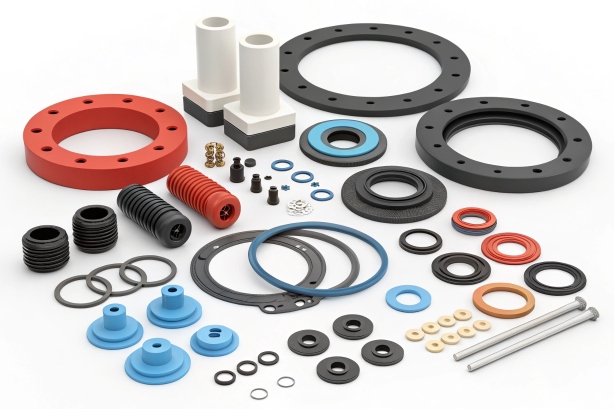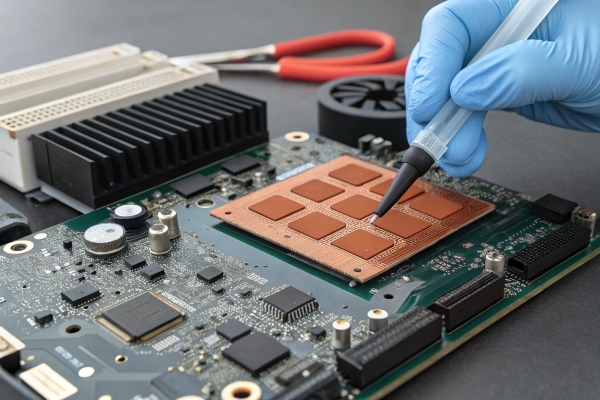Silicone rubber is known for its flexibility and resistance to extreme temperatures. But how does it perform in terms of thermal conductivity? Let’s explore.
Silicone rubber has low thermal conductivity compared to metals but performs well in applications requiring insulation and temperature resistance.
Thermal conductivity is an important property to consider when choosing materials for specific industrial applications. Silicone rubber, though not as conductive as metals, plays a crucial role in environments that demand stable thermal properties and resilience under temperature extremes.
Is Silicone Rubber a Good Thermal Conductor?
Silicone rubber is not typically used as a thermal conductor because its thermal conductivity is relatively low. However, its excellent thermal resistance makes it ideal for certain applications.
Silicone rubber has low thermal conductivity, but its high temperature stability and flexibility make it suitable for insulation and sealing.
Why is Silicone Rubber a Poor Thermal Conductor?
Silicone rubber is primarily designed to insulate rather than conduct heat. Its molecular structure limits the transfer of thermal energy, making it an excellent material for heat-resistant seals, gaskets, and protective coatings. While silicone rubber won’t transfer heat as efficiently as metals, its ability to resist heat over time and maintain flexibility in extreme conditions is invaluable in many industries.
Comparing Thermal Conductivity
Here’s a simple comparison of the thermal conductivity of various materials:
| Material | Thermal Conductivity (W/m·K) |
|---|---|
| Silicone Rubber | 0.2 - 0.3 |
| Aluminum1 | 205 |
| Copper2 | 398 |
| Steel3 | 50 |
While silicone rubber falls far behind metals in terms of thermal conductivity, it outperforms many other insulating materials.
What Factors Influence the Thermal Conductivity of Silicone Rubber?
Several factors can affect the thermal conductivity of silicone rubber, including its composition, curing process, and filler materials.
The thermal conductivity of silicone rubber is influenced by factors like fillers, manufacturing process, and the rubber's composition.
Fillers and Additives
Fillers such as silica, carbon black, and aluminum oxide can be added to silicone rubber to improve its thermal conductivity. These additives help enhance the material’s ability to transfer heat, depending on the application.
Impact of Filler Materials
| Filler Type | Impact on Conductivity |
|---|---|
| Silica4 | Lowers conductivity |
| Aluminum Oxide5 | Increases conductivity |
| Carbon Black6 | Moderate conductivity |
Silicone rubber with these fillers is often used in more specialized applications where thermal conductivity needs to be balanced with other material properties.
Manufacturing Process
The curing process also affects the final thermal conductivity of silicone rubber. A higher curing temperature can improve the structure of the rubber and allow for better heat resistance, but it might also reduce its insulating properties.
How Does the Thickness of Silicone Rubber Impact Its Thermal Conductivity?
The thickness of silicone rubber can influence its overall thermal resistance, though it does not directly increase or decrease its conductivity.
The thicker the silicone rubber, the better its insulating properties. However, thickness does not change the material's inherent conductivity.
Thickness vs. Conductivity
While the thermal conductivity of silicone rubber remains constant, a thicker layer of silicone rubber will resist heat transfer more effectively. This is why thicker silicone gaskets and seals are often used in high-temperature applications to prevent heat from escaping or entering.
Relationship Between Thickness and Thermal Resistance
| Thickness of Silicone Rubber | Thermal Resistance |
|---|---|
| 1mm | Lower resistance |
| 5mm | Higher resistance |
| 10mm | Highest resistance |
Increasing the thickness of the silicone rubber layer makes it more effective in insulating against heat but does not make the material itself a better conductor of heat.
What Are the Applications Where High Thermal Conductivity of Silicone Rubber is Beneficial?
While silicone rubber is typically not used for its thermal conductivity, there are cases where improving this property is necessary. Applications requiring heat dissipation or managing temperature changes can benefit from silicone rubber's modified thermal properties.
Modified silicone rubber with improved thermal conductivity is used in applications requiring heat dissipation, such as in electronics or automotive industries.
Key Applications
-
Electronics7:In electronic devices, efficient heat dissipation is crucial to prevent overheating. Heat conductive silicone rubber is used in components such as heat sinks, circuit boards, and LED displays. It acts as a thermal interface material, ensuring optimal performance and protecting sensitive components from thermal damage.
-
Automotive8: Silicone rubber is widely utilized in automotive applications for gaskets, seals, and insulators. It helps dissipate heat from engines, exhaust systems, and electronic components, enhancing reliability and longevity in vehicle performance.
-
Solar Panels : In solar panel manufacturing, heat conductive silicone rubber serves as a thermally conductive adhesive. It facilitates efficient heat transfer from photovoltaic cells to heat sinks, optimizing operational temperatures and maximizing energy output while extending the lifespan of solar panels.
-
Aerospace and Aviation:In aerospace, silicone rubber is employed for thermal interface materials and sealing gaskets in aircraft engines and avionics. Its high thermal conductivity and resistance to extreme temperatures make it essential for reliable performance in harsh conditions.
-
Medical Devices: Medical devices often generate heat during operation. Heat conductive silicone rubber is used in imaging equipment, surgical instruments, and patient monitoring systems to efficiently transfer heat away from critical components, ensuring safety and optimal functioning.
-
Communication Equipment: High thermal conductivity silicone pads are utilized in communication devices to reduce contact thermal resistance between heat sources and dissipation devices. This application enhances the efficiency of cooling solutions in various electronic systems.
-
Industrial Applications: In industrial settings, silicone rubber with high thermal conductivity is used in heating rollers and thermal interface sheets for effective heat transfer during manufacturing processes.
High thermal conductivity silicone rubber plays a vital role in enhancing performance across diverse applications by facilitating efficient heat management, ensuring reliability, and extending the lifespan of products in electronics, automotive, aerospace, medical devices, and more.
Why Thermal Conductivity Matters in These Applications
In electronics and automotive components, thermal conductivity ensures that heat is either dissipated or managed effectively, preventing overheating. Silicone rubber, when enhanced with fillers, helps to maintain temperature stability while ensuring the longevity of sensitive components.
Conclusion
Silicone rubber’s low thermal conductivity makes it ideal for insulation. However, with specific fillers and applications, its thermal properties can be tailored for heat management.
Footnotes:
-
Learn why aluminum has much higher thermal conductivity compared to silicone, and how it plays a role in heat transfer applications. ↩
-
Understand the superior thermal conductivity of copper, often used in heat transfer equipment, and how it compares to silicone. ↩
-
Discover why steel is commonly used in high-temperature environments and how its thermal conductivity compares to silicone rubber. ↩
-
Find out how silica impacts the thermal properties of silicone rubber, often used in seals and insulation materials. ↩
-
Explore how aluminum oxide fillers enhance thermal conductivity in silicone rubber, improving its use in heat-dissipating applications. ↩
-
Learn about carbon black fillers and their effects on silicone's thermal conductivity, making it suitable for various industrial uses. ↩
-
Check out how silicone rubber plays a vital role in managing heat in electronics and preventing overheating in devices. ↩
-
Explore the use of silicone rubber in the automotive industry, specifically in high-temperature components like engine seals and gaskets. ↩










